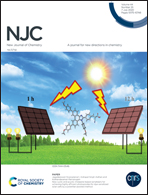Direct carbonization of black liquor powders into 3D honeycomb-like porous carbons with a tunable disordered degree for sodium-ion batteries†
Abstract
As an environmentally unfriendly and low-cost by-product produced during the manufacturing of pulp and paper, ca.170 million tons of black liquor is generated per year in the world. Efforts to effectively convert black liquor into high-value products are very critical but remain challenging. Herein, we successfully prepare porous carbons using black liquor powders as precursors through a simple carbonization technique without any extra activators or templates. The black liquor-derived porous carbons (BL-PCs) exhibit a remarkable three-dimensional (3D) honeycomb-like morphology and a hierarchical porous structure. Additionally, the disordered degree of BL-PCs can be controlled by simply regulating carbonization temperature. A combination of 3D honeycomb-like morphology, hierarchical porous structure and decreased disordered degree not only contributes to the fast electrolyte ion transport, but also improves the rate performance and cycling stability when BL-PCs are used as anode materials for sodium-ion batteries. A typical BL-PC anode exhibits attractive electrochemical performances, including high rate capability and long-term cycling stability.



 Please wait while we load your content...
Please wait while we load your content...